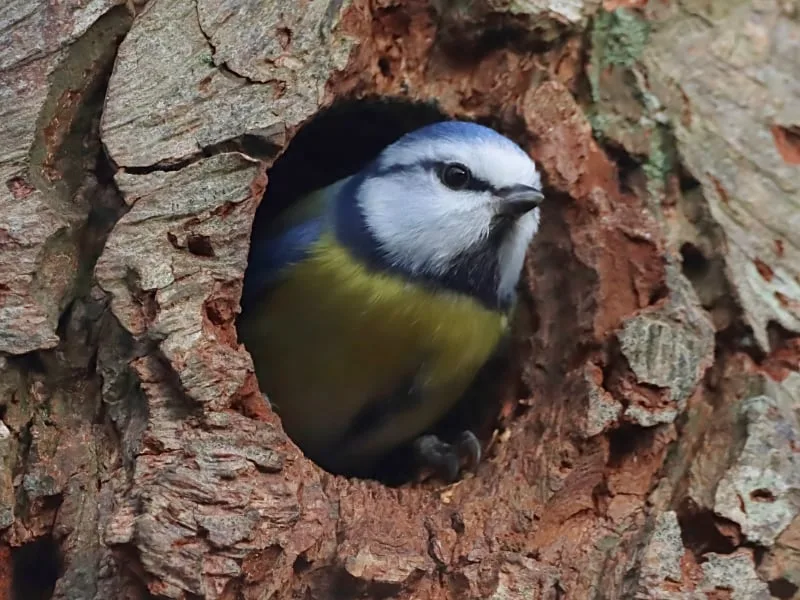The Eurasian blue tit (Cyanistes caeruleus) is a passerine bird in the family Paridae, widespread across temperate and subarctic Europe and parts of western Asia. Easily recognized by its vibrant blue and yellow plumage, it is a familiar presence in woodlands, parks, and gardens. Adaptable and resilient, the blue tit thrives in both natural and urbanized environments. As a key insect predator and occasional seed disperser, it plays an important role in maintaining ecological balance across its range.

| Common name | Eurasian blue tit |
| Scientific name | Cyanistes caeruleus |
| Alternative name | Blue tit |
| Order | Passeriformes |
| Family | Paridae |
| Genus | Cyanistes |
| Discovery | Described by Linnaeus in 1758; previously grouped under Parus caeruleus |
| Identification | Small passerine with blue crown, wings, and tail; yellow underparts; black eye stripe and white cheeks; juveniles duller with greenish hues |
| Range | Widespread across temperate and subarctic Europe and parts of western Asia |
| Migration | Primarily resident; some eruptive or altitudinal movements in northern and upland populations |
| Habitat | Broad-leaved woodlands, parks, gardens, and urban green spaces; favors oak and birch |
| Behavior | Active and agile; frequently seen hanging upside down while foraging; forms mixed-species flocks in winter; highly adaptable to urban environments |
| Lifespan | Typically 3 years in the wild; maximum recorded age is 12 years 4 months |
| Diet | Insectivorous; nestling diet dominated by caterpillars; adults also eat spiders, seeds, fruit, nectar |
| Conservation status | Least Concern (IUCN); population stable |
| Population | Estimated 62.8-100 million mature individuals globally; approximately 95% of range in Europe |
Discovery
Early documentation of the Eurasian blue tit dates back to the mid-16th century, when Swiss naturalist Conrad Gesner described and illustrated the species in his Historiae animalium (1555), referring to it as Parus caeruleus. This name was later formalized by Carl Linnaeus in the 10th edition of Systema Naturae (1758), where he classified the species under the binomial Parus caeruleus. The genus name Parus is classical Latin for “tit,” while the species epithet caeruleus means “dark blue” or “cerulean” in Latin, referring to the bird’s distinctive coloration.
In the early 21st century, molecular phylogenetic studies prompted a taxonomic revision. Analysis of mitochondrial DNA, particularly the cytochrome b gene, indicated that the blue tit formed a distinct lineage within the tit family (Paridae). As a result, the species was reassigned to the genus Cyanistes, which had previously been considered a subgenus. The genus name derives from the Ancient Greek kyanos, meaning “dark blue.”
Currently, at least nine subspecies of the Eurasian blue tit are recognized, differing slightly in plumage and range. These include the nominate C. c. caeruleus found across much of continental Europe; C. c. obscurus in the British Isles; and other subspecies distributed across the Mediterranean region, southern Russia, and parts of western Asia. In western Russia, Cyanistes caeruleus also forms interspecific hybrids with the azure tit (Cyanistes cyanus), producing individuals with intermediate plumage characteristics.
Identification
The Eurasian blue tit measures 10.5-12 centimeters (4.1-4.7 inches) in length, with a wingspan of 17.5-20 centimeters (6.9-7.9 inches), and typically weighs around 11 grams (0.4 ounces). It is a small passerine with a short neck, rounded head, and a relatively long tail.
The crown is bright blue, bordered by a dark blue line that extends through the eye and encircles the white cheeks and chin. This facial pattern gives the species a distinct and easily recognizable appearance. The nape, wings, and tail are blue, with a white wing bar and white forehead, while the back is yellowish green. The underparts are bright yellow, usually with a faint or broken dark stripe along the midline of the belly. The bill is short, pointed, and black; the legs and feet are bluish grey; and the eyes are dark brown.
There is little visible sexual dimorphism to the human eye. Both sexes are similar in plumage and size, although males may appear slightly more vibrant. Under ultraviolet light, which the species can perceive, males typically show a more intense blue crown and higher yellow chroma, especially on the breast.
Juvenile blue tits are more subdued in coloration. They display a yellower face and cheeks instead of bright white, with duller, greener wing coverts and a less vivid crown. Their plumage is generally less contrasting than that of adults. By early autumn, juvenile birds undergo a partial molt, acquiring most adult-like features, though some flight feathers and wing coverts are retained until the following spring.

The yellow coloration of the underparts is produced by carotenoid pigments obtained entirely from the diet, primarily from caterpillars. The brightness and saturation of this coloration vary between individuals, seasons, habitats, and climate conditions, reflecting differences in foraging success, food availability, and health status. Long-term studies suggest that climatic changes, particularly warmer springs and reduced rainfall, may reduce access to carotenoid-rich prey during molt, leading to paler plumage, especially in males.
Research has shown that individuals with multiple blood parasite infections tend to have paler yellow plumage, and higher levels of physiological stress are also associated with reduced carotenoid chroma. These findings suggest that plumage coloration, particularly in the yellow breast feathers, may act as an honest indicator of individual condition. While differences are subtle, they are detectable to conspecifics and may play a role in mate selection and social signaling.
Vocalizations
The Eurasian blue tit exhibits a diverse range of vocalizations used year-round, with distinct roles in social communication, predator response, and breeding behavior. Its vocal repertoire includes songs, contact calls, alarm calls, scolding, and context-specific vocalizations such as begging and copulation calls.
Listen to the Eurasian blue tit calls:
Songs are primarily used by males during late winter and early spring to defend territories and attract mates. Singing peaks before and during the egg-laying period, with a marked decline once incubation begins. Dawn singing is the most intense, especially during the female’s fertile phase, and is linked to mate guarding and stimulation of copulation. Male blue tits possess a small song-type repertoire, typically comprising three to eight types, with some shared across local populations. These songs often include a high-frequency whistle followed by a trill.
Playback studies have demonstrated that different song types convey different levels of aggression. Songs with and without trills are used in early stages of territorial interaction, while scolding-like vocalizations are associated with escalated responses and closer-range threats. Males may exhibit song type matching during interactions, although this behavior is often replaced by direct approach when physical confrontation is imminent.
Blue tits also produce specific calls for intra- and interspecific communication. Contact calls help individuals maintain cohesion while foraging in trees. Alarm calls are used to alert conspecifics and heterospecifics, such as great tits, robins, and treecreepers, of potential threats. These calls vary by predator type: low-pitched scolding occurs in response to ground-based or perched predators, often followed by mobbing, while a high-pitched whistle is typically used to signal aerial predators such as sparrowhawks or buzzards. Notably, both males and females have been observed singing in response to predator threats, a rare behavior among temperate songbirds. Female singing under these circumstances is structurally similar to male song and may function in deterrence or coordinated defense.
During copulation, both partners may emit high-pitched “zeedling” notes. Nestlings develop begging calls over three distinct stages, transitioning from low-frequency tonal calls in the first days post-hatching to louder, hiss-like broadband calls shortly before fledging. These vocalizations are critical for stimulating parental feeding and are sensitive to environmental conditions. Exposure to anthropogenic noise can interfere with call transmission and parental interpretation, particularly during early and transitional phases, potentially affecting chick development and condition.
Range
The Eurasian blue tit is widely distributed across temperate and Mediterranean regions of Europe and parts of western Asia. Its range extends from the Iberian Peninsula and the British Isles in the west to the Ural Mountains, northern Iran, and the Zagros range in the east. The species is common across most of France, Germany, Poland, the Balkans, and southern Scandinavia, with populations established from Portugal and Ireland to southern Finland and European Russia. To the south, it occurs across the Mediterranean basin, including Italy, Greece, Turkey, and many major islands such as Corsica, Sardinia, Crete, Rhodes, and the Balearic Islands. Isolated populations are found along the southern Caspian coast, in the Caucasus, northwestern and northern Iran, and the Zagros Mountains.

The species is considered native throughout most of Europe, including all EU and EFTA countries except Malta (where it is a vagrant) and Iceland (where it is absent). It is also native in Armenia, Azerbaijan, Belarus, Georgia, Iran, Iraq, Jordan, Kazakhstan, Lebanon, Libya, Moldova, Morocco, Russia, Syria, Tunisia, Turkey, and Ukraine. Its elevational range includes lowlands, foothills, and montane forest zones, particularly in southern and eastern parts of its distribution.
The nominate C. c. caeruleus occupies most of continental Europe from northern Spain and Sicily to northern Turkey and the Urals. C. c. obscurus occurs across the British Isles. C. c. ogliastrae inhabits Portugal, southern Spain, Corsica, and Sardinia, while C. c. balearicus is restricted to Majorca. C. c. calamensis is found in southern Greece, Crete, and adjacent islands. Eastern subspecies include C. c. orientalis (southern Russia), C. c. satunini (Crimea, the Caucasus, and parts of Iran and eastern Turkey), C. c. raddei (northern Iran), and C. c. persicus (Zagros Mountains). These subspecies reflect local adaptations in morphology and plumage and occupy a broad range of bioclimatic zones across the Palearctic.
Migration
The Eurasian blue tit is primarily a resident species, but its migratory behavior varies regionally and is influenced by age, sex, and environmental conditions. Across much of its central and northern range, the species engages in irregular eruptive movements, particularly in response to food shortages or harsh winter conditions. These movements are typically directed westward or southward and may involve large numbers of individuals. In contrast, populations in southern Europe and western Asia are largely sedentary, although some birds undertake altitudinal migrations, descending from higher elevation breeding areas to lower ground in winter.
Long-term studies indicate that blue tits exhibit partial migration, with juveniles (especially females) being more likely to migrate than adults or males. Migration distance is not fixed; data from southern Germany show that between the 1960s and 1990s, blue tits progressively shortened their average migration distance in response to milder winters. This trend has been linked to broader climate change effects and allows birds to remain closer to breeding grounds, improving synchronization with early spring resource availability. These changes are also associated with advances in laying dates, particularly in single-brooded populations.
Although blue tits are not considered long-distance migrants, continental birds occasionally reach the British Isles in autumn, especially during irruptive years. Such movements highlight the species’ flexibility in coping with environmental variation and its capacity for behavioral adaptation in the face of changing climatic conditions.
Habitat
The Eurasian blue tit occupies a wide range of habitats dominated by broad-leaved and mixed woodlands, with a marked preference for forests containing oak and birch. It generally avoids extensive coniferous stands. In addition to natural woodlands, the species frequently inhabits coppices, hedgerows, parks, suburban gardens, and even urban centers, provided suitable foraging conditions and nesting cavities are present.
While often considered a habitat generalist, local breeding success is influenced by tree composition and diversity. A study across Scottish woodlands found that territories with high tree diversity, especially those including oak, birch, and sycamore, supported higher fledging success. These tree species are important as they host caterpillar populations essential for chick development. Despite using a variety of trees for foraging, blue tits show strong preferences for oaks when available, likely due to their higher invertebrate biomass.
Behavior
The Eurasian blue tit exhibits a wide range of behavioral adaptations shaped by habitat, season, and individual variation. It is an active and agile species, often foraging acrobatically at the tips of twigs, hanging upside down in search of small invertebrates. During the breeding season, individuals typically forage alone or in pairs, while outside of it they frequently join mixed-species flocks, commonly with great tits (Parus major), long-tailed tits (Aegithalos caudatus), and other small passerines. In these flocks, blue tits usually take a subordinate role but benefit from collective vigilance and shared access to resources.

Individual blue tits differ consistently in their responses to novelty, forming distinct behavioral types, ranging from bold to shy. These personality traits influence foraging decisions, flexibility in unpredictable environments, and even parental strategies. Some studies suggest that complementary pairings, such as a bold female with a shy male, may enhance breeding performance. These traits appear stable over time and are particularly relevant in urban settings, where behavioral plasticity aids survival.
Defensive behaviors are also well developed. Females show direct aggression toward intruding conspecifics when defending limited nest sites, and both sexes may engage in a unique anti-predator behavior: a sharp hissing sound produced from within the nest cavity, mimicking a snake. These two behaviors, female-female aggression and hissing, are expressed independently, reflecting distinct behavioral axes rather than a single underlying temperament.
In addition to visual and vocal cues, blue tits make use of olfactory information. They can detect changes in the aromatic composition of their nest and briefly hesitate to enter when familiar scents are altered. This sensitivity suggests roles for scent in nest recognition or environmental assessment.
Roosting behavior during the non-breeding season involves solitary use of cavities or nest boxes, with pronounced seasonal changes in sleep duration. Winter roosting can exceed 14 hours per night, decreasing to around 8 hours by late spring. Despite this variation, birds maintain a stable midpoint of sleep and typically leave the roost shortly before dawn. Warmer nights are associated with more frequent nocturnal arousals, indicating sensitivity to ambient temperature.
Blue tits also engage in interspecific communication, responding to alarm calls from other woodland species and contributing to communal warnings when predators are present. In urban and suburban environments, they show a high degree of adaptability: regularly using bird feeders, exploiting novel food sources, and nesting in artificial boxes. Their readiness to breed in human-modified habitats, combined with their responsiveness to subtle environmental changes, such as altered visual or scent cues, reflects strong spatial awareness and ecological flexibility.
Breeding
The Eurasian blue tit is a socially monogamous passerine, typically forming breeding pairs shortly before the onset of the breeding season in early spring. Courtship behaviors include male singing, food offering, and increased physical proximity. Most pairs form for a single season, although mate retention between years can occur and may influence parental behavior.
Breeding begins from late March to early May, depending on latitude and environmental conditions. In urban populations, breeding often starts slightly earlier than in nearby rural habitats, possibly due to higher ambient temperatures or anthropogenic food availability. A single brood per year is most common, though some individuals may attempt a second clutch if time and resources allow.
Nesting and egg laying
Nest sites are typically found in natural cavities or artificial nestboxes, with the female selecting the site and constructing the nest. Blue tits show a strong preference for enclosed spaces with entrance holes around 28-29 mm in diameter. Nest building materials primarily include moss, dry grasses, feathers, and animal fur, which provide insulation and support for the developing clutch.

Egg laying usually begins in April, with clutch sizes ranging from 7 to 13 eggs. Clutch size can vary by habitat, year, and female quality, and tends to be larger in forest habitats than in urban environments. Females lay one egg per day and typically complete the clutch within two weeks.
Incubation, fledging, and parental care
The female incubates the eggs alone for about 13-15 days, relying on the male to provide food during this period. After hatching, both parents participate in feeding the chicks, which remain in the nest for approximately 16-21 days before fledging.
Parental investment is influenced by environmental factors and individual condition. In disturbed urban habitats, breeding success may decline during periods of high human activity, as parents may reduce feeding visits in response to nearby disturbance. Female provisioning rates are often responsive to brood demand and partner effort, while male provisioning may be more consistent but less flexible. Retaining the same nest-site or mate does not always result in improved reproductive success, suggesting complex interactions between experience, habitat quality, and individual behavior.
Fledging success varies with habitat and weather conditions. Cooler, rainier springs generally reduce chick mortality by limiting human disturbance in urban parks, while in forests, warm weather usually enhances breeding success. Despite lower reproductive output in some urban areas, blue tits remain successful colonizers due to their adaptability and use of artificial nesting sites.
Lifespan
The Eurasian blue tit typically lives around 3 years in the wild, largely due to high mortality during the first year of life. An analysis of ring-recovery data from Britain showed that juvenile survival in their first year is only about 38%, while adult annual survival is approximately 53%. Despite the low average, some individuals can live considerably longer, with the maximum recorded age being 12 years and 4 months.
Mortality is influenced by various ecological and seasonal factors. Harsh winters can lead to increased mortality, especially in juveniles, due to limited food resources and exposure to cold. Nest predation, parasitism, and competition for nest sites also affect survival rates. Urban and fragmented habitats may further reduce lifespan by increasing vulnerability to predators and lowering food availability.
Diet
The blue tit is an insectivorous passerine whose diet is dominated by caterpillars, particularly during the breeding season. Adult blue tits exhibit flexible foraging behavior, adjusting prey choice in response to the developmental stage of their nestlings. The diet of nestlings consists primarily of Lepidoptera larvae, especially Tortricidae (leaf-rollers), Noctuidae (cutworms), and Geometridae (inchworms). Nestlings also receive spiders and other arthropods, including beetles and hymenopterans, though these make up a smaller portion of the overall diet. Despite the considerable difference in caterpillar sizes among families, parents showed no strong limitation due to gape-size constraints when feeding 7-day-old chicks, and large prey like noctuids were delivered throughout the nestling period.

Parental provisioning behavior varied with nestling age. At earlier stages, females tended to invest more effort in provisioning and brought a higher proportion of small prey such as tortricid larvae, possibly due to time constraints imposed by brooding and nest maintenance duties. Spiders were also more common in the diet of younger nestlings, likely because they are rich in taurine and calcium, both of which are important for the early development of vision, cognition, and bone mineralization. As chicks grew older and their energy demands increased, both male and female parents shifted to delivering larger food loads more efficiently, though feeding rates per chick remained relatively stable. These changes reflect an adaptive response to the growing needs of the brood and variations in prey availability over the nestling period.
Recent studies confirm that caterpillars make up over 70% of all prey delivered to chicks, with slightly higher proportions in oak-rich habitats (82.4%) compared to poorer ones (73.6%). In habitats with low caterpillar availability, parents compensated by doubling their average foraging distance, from 25 to 53 meters, and by selecting larger prey, thereby maintaining a similar biomass intake per chick per hour. This compensation strategy allowed blue tits to avoid increasing energy expenditure, as longer trips were balanced by reduced visit frequency. However, reproductive success followed a saturation curve in relation to caterpillar availability: once daily frass production dropped below approximately 500 mg/sq m, parental compensation became insufficient. In richer habitats, blue tits raised larger broods with heavier nestlings, underscoring the importance of food quality and abundance for breeding outcomes.
Culture
Although the Eurasian blue tit lacks the deep mythological associations of some other birds, it holds a modest place in European folklore, symbolism, and popular imagination. In British and Northern European traditions, it has often been admired for its agility, boldness, and bright plumage. Known in older English dialects as the “tom tit” or “titmouse,” it features in folk rhymes and local stories, usually as a cheerful and clever little bird.
Perhaps the most famous cultural anecdote involves the blue tit’s learned behavior of opening foil-topped milk bottles to steal cream, first observed in the 1920s and widely reported across Britain by the 1950s. This inventive act became emblematic of the species’ adaptability and intelligence and remains a frequently cited example of cultural transmission in animals.
Symbolically, the blue tit is associated with liveliness, curiosity, and renewal, often linked to springtime due to its increased activity during the breeding season. While it rarely appears in classical literature, it has found a place in modern poetry and nature writing, where it often represents the charm and vitality of garden birdlife. Its striking colors and acrobatic foraging habits also make it a common subject in bird-themed art, children’s books, and environmental education materials, especially in the UK and Western Europe.
Threats and conservation
The Eurasian blue tit is currently listed as Least Concern, with an extensive and stable population across its range. In Europe, which holds approximately 95% of the species’ global population, the estimated number of mature individuals ranges between 59.7 and 95.1 million, corresponding to 29.8-47.6 million breeding pairs. This yields a global estimate of 62.8-100 million mature individuals, although further validation is desirable.
Over the last three generations (10 years), no significant declines have been observed, and the European population is considered stable. In Sweden and other parts of northern Europe, the species has expanded northward, with populations now breeding beyond the Arctic Circle. This range expansion and a 30-50% increase in numbers over the past three decades have been linked to climate warming, with breeding dates advancing by approximately 10 days in response to warmer springs.
Despite its overall success, blue tit populations can be affected by several natural and anthropogenic pressures. The species experiences high annual and local fluctuations, influenced by habitat quality, food availability, winter mortality, and competition, especially with the great tit (Parus major), which may outcompete blue tits for nesting sites. In habitats with limited caterpillar abundance, such as coniferous forests, productivity tends to be lower, with increased rates of nestling starvation. In parts of northern Europe, predation by pine martens has emerged as a major cause of nest failure, responsible for total brood loss in a notable number of nests.
Additionally, while not systematically targeted, the species may occasionally be trapped using glue sticks or mist nets, kept as pets, or served as a delicacy, though there are no reliable data on the scale of this activity.
Conservation measures are currently not required at a global level. The blue tit benefits from extensive use of bird feeders in winter, which likely contributes to higher overwinter survival rates, particularly during harsh conditions. The species is listed under Appendix II of the Bern Convention, ensuring a basic level of legal protection across much of its range. Ongoing monitoring and long-term research programs continue to track its population dynamics, range shifts, and breeding phenology, especially in the context of climate change and habitat alteration.
Similar species
The Eurasian blue tit (Cyanistes caeruleus) can be confused with several other small passerines, especially in mixed flocks or at feeders. These species often share similar size, coloration, or habitats, making field identification challenging for beginners.
Great tit (Parus major)

The great tit is the most commonly confused species. While it is larger than the blue tit, it also has yellow underparts and a dark cap. However, the great tit shows a black head with white cheeks and a distinctive black central stripe down the breast, lacking the blue crown and white wing bar seen in blue tits.
Azure tit (Cyanistes cyanus)

The azure tit closely resembles the blue tit in structure and behavior, especially in hybrid zones across eastern Europe. It has a much paler appearance, with white cheeks, a light blue back and crown, and an absence of yellow in the plumage. These features give it a colder, more subdued look compared to the vibrant coloration of the blue tit.
Coal tit (Periparus ater)

The coal tit is smaller and more subdued in color, with a black cap and white nape patch. It lacks the blue and yellow coloration of the blue tit but can be mistaken for one in fast-moving flocks, especially in dense coniferous woodland where light conditions are poor.
Crested tit (Lophophanes cristatus)

The crested tit, found in parts of central and northern Europe, is similarly sized but easily recognized by its pointed crest and facial markings. Although its plumage is more brown and gray, its behavior and voice overlap with that of the blue tit, leading to occasional confusion in mixed feeding groups.
African blue tit (Cyanistes teneriffae)

Once considered a subspecies of the Eurasian blue tit, the African blue tit is now treated as a distinct species, found on the Canary Islands and parts of North Africa. It closely resembles its Eurasian counterpart in plumage but often shows a darker blue crown and broader black eye-stripe. Vocalizations and genetic divergence support its separate status. While their ranges do not typically overlap, their similar appearance can cause confusion in field guides or older literature.
Future outlook
Despite facing localized challenges, the Eurasian blue tit remains a widespread and resilient species with a stable population across most of its range. Its adaptability to a range of habitats, including urban environments, and its responsiveness to supplementary feeding have likely contributed to its success. However, ongoing changes in climate, habitat structure, and insect phenology may alter food availability during the critical breeding season, potentially disrupting the tight timing between chick development and prey abundance. Long-term monitoring of population trends, breeding success, and phenological mismatches will be essential to anticipate and mitigate future pressures. Continued public engagement through nestbox programs and citizen science initiatives will also play a vital role in supporting both research and conservation of this iconic European songbird.
